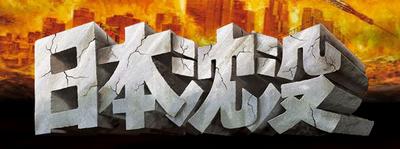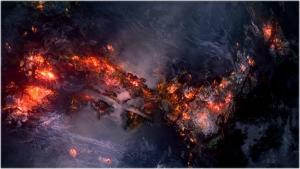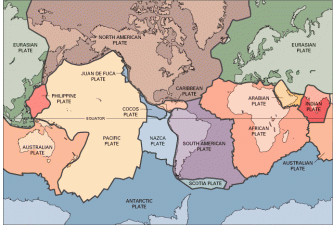“I have but one more question for you. For a scientist, what is the most precious thing?” “Intuition,” answered Tadokoro without hesitation. “Mmm?” The old man cupped his hand to his ear. “What is it?” “I said intuition sir,” said Tadokoro. “You may think it’s strange, but for a scientist – especially for a natural scientist – far and away the most precious gift he can possess is that of keen intuition. Without it, he’ll never make a notable break-through.” (Komatsu 51)
Introduction
The intuition is the accident that is happening in the Japanese archipelago. Geophysicist, Dr. Yusuke Tadokoro sets to embark on research. Tadokoro and his team of researchers come to discover a strange flow and crack running through the ocean floor. Tadokoro was convinced with his hypothesis and continues to collect data. They came to a conclusion of one. That was within two years, in the worst case, most of the Japanese archipelago will sink beneath the surface of the sea.
Mr. Komatsu’s premise in “Japan Sinks” was that the tectonic plates that grind beneath the Japanese archipelago undergo a sudden colossal shift, setting off a chain reaction of volcanoes that spew torrents of lava, tsunamis that inundate cities, earthquakes that shatter the countryside and the deaths of millions of people. (New York Times, 2011)

Japan Sinks was written in 1973 by Sakyo Komatsu and then later translated by Michael Gallangher in 1976 and published in the United States.
Biography

Sakyo Komatsu was born in Osaka in 1931, and attended Kyoto University where he studied Italian literature. After college, he was involved in writing for magazines and doing work for stand-up comedy acts. He began his true writing career in the 1960’s and his most popular works outside of Japan are Japan Sinks and Sayonara Jupiter. Both of which have been turned into various forms of comics and movies. In 2011 on July 26th, Komatsu passed away at the age of 80 years old from pneumonia in Osaka.
Book Summary
 Japan Sinks starts off with the account of a small island sinking overnight. There was a fishing boat anchored at this island in the northeast part of the Ogasawara chain for the night, the fishermen woke the next morning to find themselves in the middle of an empty sea.
Japan Sinks starts off with the account of a small island sinking overnight. There was a fishing boat anchored at this island in the northeast part of the Ogasawara chain for the night, the fishermen woke the next morning to find themselves in the middle of an empty sea.
While still not totally sure what to think of the recent findings, massive earthquake and volcanic eruptions soon become more frequent throughout Japan.After this is reported, the Japanese Weather Service sends a vessel to investigate. Onodera, the engineer who pilots the deep-sea submarine, and Dr. Tadokoro set out to scan the sea floor near the sunken island. They find that the island had indeed sunk overnight.
Upon help from the Japanese government, further research, and with the disaster situation worsening, Tadokoro warns that the Japanese archipelago may sink to the ocean floor. This information is kept as top-secret as further research and planning goes on to avoid public chaos.  As events become even more intense nationwide, a plan to evacuate all of the Japanese people to other countries begins.
As events become even more intense nationwide, a plan to evacuate all of the Japanese people to other countries begins.
A plan known as “plan D” is formed, top scientists and government officials are assigned to this plan to continue research. Their findings revealed that due to a change of mantle convection around the Japan Trench, the Japanese archipelago will sink into the sea in about two years at the earliest. As time passed, further research revealed that there was only less than one year left before all was lost.
Talks continued to go on between nations such as Australia, China, Russia, Africa, and the United States to accept Japanese citizens as refugees. Suspicion throughout the international community began to rise, Japanese bonds were being sold out, which started to leave Japan feeling helpless and abandoned.
Japan eventually becomes submerged in the sea while still being torn from East to West.  The some 70 million Japanese that were fortunate to evacuate, had become a “wandering people” scattered all over the world.The Japanese citizens had great trust in their government and complied with evacuation procedures even though they were not completely aware of the situation. Throughout all of this, more earthquakes and volcanic eruptions continued violently, killing millions.
The some 70 million Japanese that were fortunate to evacuate, had become a “wandering people” scattered all over the world.The Japanese citizens had great trust in their government and complied with evacuation procedures even though they were not completely aware of the situation. Throughout all of this, more earthquakes and volcanic eruptions continued violently, killing millions.
Plate Tectonics
Vibration and Movement
There are plates of varying sizes that make up the Earth’s surface. The six pieces of the large-scale plates; their names are derived from the name of the continent, such as “North American plate”, “Africa plate”, and “Antarctic plate”.

Some plates may be small in size when compared to others, but in terms of shaping the earth they are very important in the same way. Juan de Fuca plate is also a minimal one, but the impact of volcanoes that dot the Pacific Ocean America Northwest Coast are numerous.
A plate constitutes the outer shell of the earth called the lithosphere. The lithosphere, is the top of the mantle and crust, and the like. Convection lava in the lower layer and turbulence, will force the plate to move like a conveyor belt. Most of the geological activity is due to the interaction of these plates or separate collisions of broken plates.
Boundaries of geological structures can be divided into three types by the motion of the plate. It is three types of transformations that will cause a strike-slip plate while interacting and diverging, When this happens the plates are gradually divided.

Convergent boundary
This is where the plate is a landmass between the collision. This boundary is formed by the mountain ranges of the myriad of wrinkles that could be in the crust. Asia and India collided together about 55 million years ago, it was pushed slowly and formed the Himalayan mountain system which is the highest on Earth. Such squashing continues, forcing mountains to rise even higher accordingly. Everest, may become higher tomorrow than it is today.

Convergent boundary occurs at the place when it dives beneath the continental plate in a process that involves the oceanic plate, known as subduction. Thereby, the upper plate is lifted , and mountains are formed there as well. In addition, there are also occasions when the plate of concern slips and melts, and it ends up becoming a spewing volcanic eruption. For example, some of the Andes mountains in South America were so formed.
The convergence between the oceanic plate, the plate of one dives beneath the other plate, deep trenches such as the Mariana Trench which is the deepest North Pacific Ocean is formed on the planet most of the time. The collision of this type may have enacted underwater volcanoes that are thought to have made up the island arc like Japan.
- Learn about the tectonic similarities between Japan and the Pacific Northwest U.S. in this interactive animation.
Divergent boundary
In the divergent boundary of the ocean, magma has risen to the surface from deep in the Earth’s mantle. Mountains and volcanoes occur along this seam. The shape of the seabed changes by this process, a huge basin to expand. This mid-ocean ridge system of one connects the world’s oceans, the ridge is known to be the world’s longest mountain range.

Where the plate is pulled in opposite directions of each other on the ground, a huge rift Great Rift Valley (such as the Great Rift Valley of Africa) is formed. The plate continues its separation as it is, this shows how that East Africa is separated from the continent several million years later and a new land mass was formed. The boundary between the plates at that time were a mid-ocean ridge.
Transform type boundary
The San Andreas Fault in California, is a typical example of a transform boundary type. You are rubbing two plates along a strike-slip fault. This spectacular terrain such as mountains and oceans are not born at the boundary like this, but it is caused by a major earthquake triggered by irregular movement in most cases.

The earthquake of 1906 that devastated San Francisco is one example.
Mantle convection
Mantle, is made up of solid stone; hard in the sense day-to-day. However, (hereinafter referred to as the rheology field to study the mysterious nature of such materials) it behaves like a fluid like when viewed over a long period of time.

It is believed to release the extraterrestrial heat of the earth’s interior and the cooling heat of the core. With the heat generation in the mantle, convection starts at a slow rate. Originally mantle convection is what receives the continental drift theory of Wegener and Holmes of the United Kingdom and has been proposed as a driving force for continental drift. At present, it is not considered to be caused by mantle convection and it is compatible and just plain plate motion. However, it is important to rule that the convection is present in the mantle, and with the various geological phenomena occurring within the mantle, including the Earth’s surface, there is no doubt that it is a process that exists. Research has been actively conducting experiments and numerical simulations to prove this. One way to demonstrate the progress of the study the earth’s internal structure would be to consider an earthquake wave (mantle tomography), the convective motion is what is happening and is what has been brought to light in recent years.
How Shifting Plates Caused the Earthquake and Tsunami in Japan
Deep Sea Submarines
In a deep-sea submarine, there is a spherical pressure hull. High-strength steel has been used previously for the hull, but titanium has mainly been used since the 1980’s. Power is supplied from batteries, which in recent years are lithium batteries.

These vessels are usually equipped with different forms of cameras, robotic arms, according to the purpose of its use. It is possible to send images and sounds to the mother ship with ultrasound, but there is a limit to the transmission capacity band. Compared to past compression techniques, they may have improved to some extent in recent years, but still the problem is not completely solved. In recent years, the motor is a mainstream AC induction motor. With discharge characteristics that are excellent even at low temperatures, for long life cycles that contribute to cost reduction. Gasoline was used previously as buoyancy material, but this hardened with epoxy resin micro balloons silica is used presently. Mercury was used in the past for adjusting the inclination of the hull, but the model which moves the center of gravity by moving the ball tungsten connected as beads instead of mercury as Turtle and Sea Cliff in recent years some. The ball of tungsten enters on one side of the ball made of buoyant material is continuous with half a ball of tungsten, to compensate for the volume that you moved in that the buoyancy, material enters the tank on the opposite side by the same number. Manned submersible boats were built various countries until the 1970’s.

The performance of remote-controlled unmanned spacecraft technology has vastly improved since the 1980’s, resulting in the number of manned submersible boats used to be reduced. Operating expenses, including the support of the mother ship, such as remote control unmanned spacecraft is to be less than 1/10 as compared to the manned submersible with a diving capacity of deeper capability. Further, it has become possible to fly drones in the sky with the advancement of technology, that was previously impossible without being manned. In addition, the operation to control the unmanned submersibles compared to manned submersibles has helped in the investigation of the Titanic at the ocean floor. Self-ROV, which do not require the manipulation of a cable in recent years have been developed, and it has become possible to continuously navigate over long distances.
Relevance to the Novel
This convection and moving and colliding of the plates is the basis of how Japan is sunk under the sea in the book. When the plates collide, it basically pulls and forces the other down with it. This causes the plate, with violent changes happening rapidly, along with the whole Japanese Archipelago that is a part of it to become submerged. The use of deep-sea submarines manned by researchers, was a very useful tool to investigate the depths first hand.
- Hevesi, Dennis. “Sakyo Komatsu, 80, Science Fiction Writer, Dies at 80.” Editorial. New York Times. New York Times, 10 Aug. 2011. Web. 2 July 2014. <http://www.nytimes.com/2011/08/11/arts/sakyo-komatsu-science-fiction-writer-dies-at-80.html?_r=0>.
- “Home — Kyoto University.” Home — Kyoto University. N.p., n.d. Web. 02 July 2014. <http://www.kyoto-u.ac.jp/en>.
- “How Shifting Plates Caused the Earthquake and Tsunami in Japan.” The New York Times. The New York Times, 10 Mar. 2011. Web. 02 July 2014. <http://www.nytimes.com/interactive/2011/03/11/world/asia/maps-of-earthquake-and-tsunami-damage-in-japan.html?_r=0#panel/0>.
- “Interactive Animations.” IRIS –. Incorporated Research Institutions for Seismology, n.d. Web. 02 July 2014 <http://www.iris.edu/hq/programs/education_and_outreach/animations/interactive#P>.
- “Japan Sinks.” Wikipedia. Wikimedia Foundation, 07 Jan. 2014. Web. 02 July 2014. <http://en.wikipedia.org/wiki/Japan_Sinks>.
- John. “Japan Is Sinking! Or Is It?” Web log post. Tofugu. Tofugu, 01 Mar. 2013. Web. 02 July 2014.<http://www.tofugu.com/2013/03/01/japan-is-sinking-or-is-it/>.
- Komatsu, Sakyō. Japan Sinks. Trans. Michael Gallagher. New York, N. Y.: Harper & Row, 1976. Print.
- “OSAKA INFO -Osaka Visitors’ Guide.” OSAKA INFO -Osaka Visitors’ Guide. N.p., n.d. Web. 02 July 2014. <http://www.osaka-info.jp/en/>.
- “Plate Tectonic Animation – Earthguide Online Classroom – Plate Tectonics Animations.” Plate Tectonic Animation – Earthguide Online Classroom – Plate Tectonics Animations. Scripps Institute of Oceanography, n.d. Web. 02 July 2014. <http://earthguide.ucsd.edu/eoc/teachers/t_tectonics/t_tectonics.html>.
- “Sakyo Komatsu.” Wikipedia. Wikimedia Foundation, 07 Jan. 2014. Web. 02 July 2014. <http://en.wikipedia.org/wiki/Sakyo_Komatsu>.
- “StarrTech Interactive.” StarrTech Interactive. N.p., n.d. Web. 02 July 2014. <http://www.japantravelinfo.com/imap/flash.html>.
- “Submarines & Deep Technology.” Submarines and Deep Technology. MarineBio, n.d. Web. 02 July 2014. <http://marinebio.org/oceans/submarines/>.
- “This Dynamic Earth–Contents [USGS].” This Dynamic Earth–Contents [USGS]. United States Geological Survey, 1996. Web. 02 July 2014. <http://pubs.usgs.gov/gip/dynamic/dynamic.html>.
- “Welcome to the USGS – U.S. Geological Survey.” Welcome to the USGS – U.S. Geological Survey. USGS, n.d. Web. 30 June 2014. <http://www.usgs.gov/>.

Reblogged this on drylandjapan.